The Brazos Performance Preview: AMD E-350 Benchmarked
by Anand Lal Shimpi on November 16, 2010 12:01 AM ESTMobile IGP Comparison
I narrowed down the platforms for our mobile IGP comparison. I simulated a Core i3 350M by taking an i3-530, underclocking it (I couldn't do anything about the 4MB vs. 3MB L3 cache) and capping its GPU frequency at 667MHz. This is the best case scenario for the i3-350M, and as you'll see below, it doesn't really matter. I also paired a 2.2GHz Pentium Dual-Core with a G45 motherboard, agian simulating the cheaper mobile Pentium platform. Finally I installed Windows 7 on the 1.6GHz Core 2 Duo based 11-inch MacBook Air with its GeForce 320M to give you an idea of the upper bound for mobile performance with what might as well be a low end discrete GPU.
Updated: I've added performance results from a simulated Core i3-330UM, the E-350's competition in ultra portables.
We'll start with Modern Warfare 2:
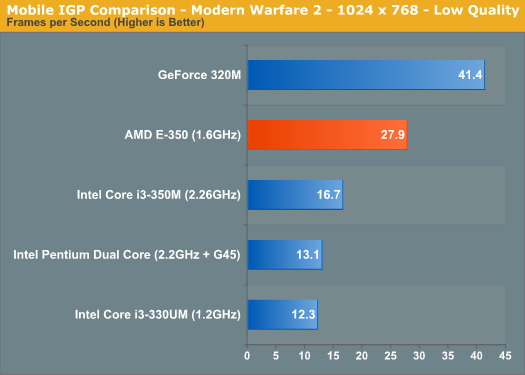
The E-350 puts the i3-350M, i3-330UM and Pentium DC to shame, delivering 67% better performance. The frame rate is just shy of being totally smooth however. I found that in most modern games 1024 x 768 would result in frame rates just under 30 fps.
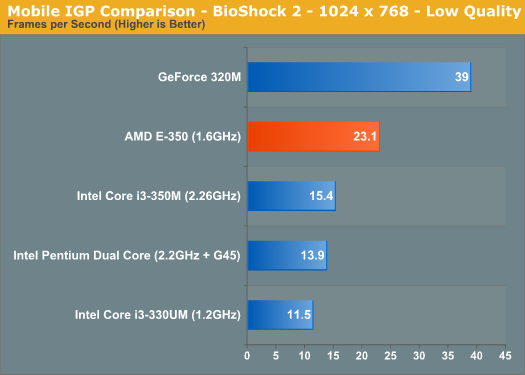
BioShock 2 showed a similar performance advantage. Again we're not able to break 30 fps but the performance advantage is huge compared to the Intel platforms with integrated graphics.
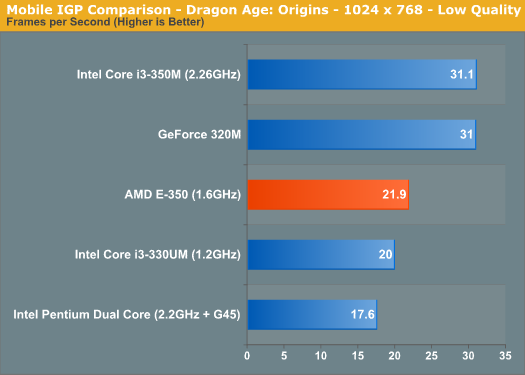
Dragon Age: Origins is mostly CPU bound at low quality settings and thus there's no real advantage to the E-350's Radeon HD 6310 GPU. It's faster than the Pentium/G45 platform, but significantly slower than the i3-350M. I expect most games however to be GPU bound at these settings across the board.
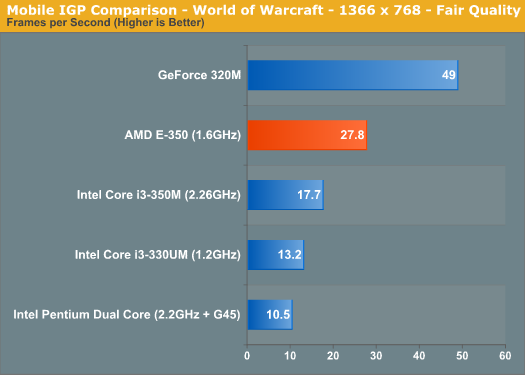
World of Warcraft continued the trend. The E-350 ended up 57% faster than the i3-350M, although still fell short of a discrete GPU.
Of course I wondered how well Brazos would play Starcraft 2:
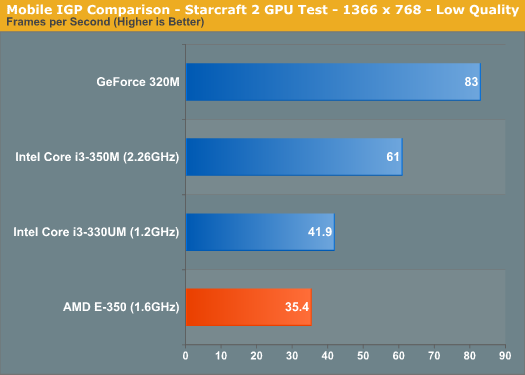
The GPU handles SC2 just fine, however the game is very CPU dependent and thus you see a pretty big advantage from the mainstream i3 system. The comparison is a lot closer when we look at the i3-330UM. The E-350 won't be able to play SC2 as well as a $500 mainstream notebook, but it'll be comparable to an ultraportable running ULV Arrandale.
We don't have numbers for the G45 platform here because the system wouldn't run our benchmark (our tests use an older version of SC2 which apparently had issues with the G45 drivers).
Our SC2 CPU test gives you an idea of the lower end of performance in large multiplayer battles:

The E-350 offers only 58% of the performance of the i3-350M system. The Bobcat cores do hold the platform back from time to time. Again, compared to the i3-330UM there's no performance difference at all.
Just for kicks I also ran the Civilization V benchmark, which gave us two datapoints: GPU performance and no-render/CPU performance.
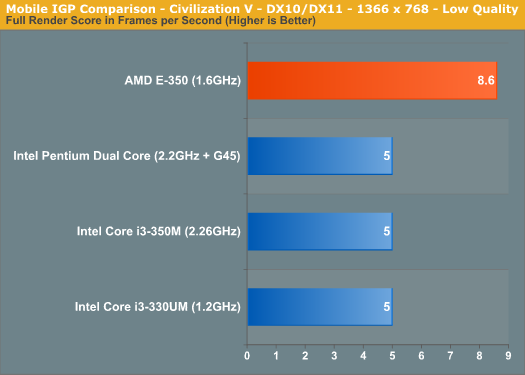
The benchmark doesn't score well on either platform, although AMD does hold a 72% performance advantage over the i3 and G45 platforms. The CPU test puts the E-350 at about 55% of the speed of the Pentium dual core platform.
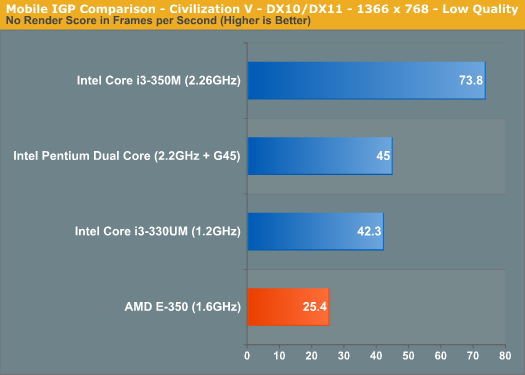
Civ V is one area where the Arrandale CPU advantage wins out over GPU performance.
Overall, the E-350 has no problems outperforming any of the current Intel integrated graphics offerings in 3D games. In CPU bound titles the E-350 loses out to the mainstream i3, but is competitive with ultra low voltage i3s. Just as with Atom, you'll have to sacrifice performance vs. a mainstream notebook, but compared to low voltage Arrandale the E-350 can hold its own.










207 Comments
View All Comments
ET - Tuesday, November 16, 2010 - link
I'm not saying it's a bad product, and as I said it should draw the OEM's. What it doesn't do is change the kind of products available. It's not significantly faster, doesn't really allow gaming, it's just another entry point that's not bad. It will power yet another bunch of low cost notebooks that can only be used for everyday tasks. At the netbook side it may be a little more convincing, since it saves the need for an extra chip for video, and benchmarks showed a significantly higher javascript speed compared to an Atom, which matters. But still, there's no wow factor about it.As a consumer I will certainly prefer an AMD netbook with this chip to an Atom based one, it's just that I was hoping for more. From my point of view, the advantage of such a netbook over Atom+Ion:
- Lower price
- Perhaps smoother everyday use (hinted at by the javascript benchmark)
- No artificial hardware limits, far as I know, so I expect to see a "netbook" with 4GB of RAM (or at least upgradeable to that)
- If I'd want to try Direct3D development on it (which I did in the past on similar strength hardware), I'll have the full DX11 feature set, even if at very low speed.
flyck - Tuesday, November 16, 2010 - link
it IS significantly faster. What the benchmarks do not show is single threaded applications. Single threaded is dead slow on Atom. e.g. starting an application/user interfaces all single threaded will feel slugish on Atom and not on Ontario.1Ghz Bobcat equals around 1.6GHz Atom cpu in single threaded applications how is that disappointing for a smaller cpu?
ET - Tuesday, November 16, 2010 - link
> 1Ghz Bobcat equals around 1.6GHz Atom cpu in single threaded applications how is that disappointing for a smaller cpu?Because as a consumer I don't care at all whether the CPU is smaller. I care about performance (and I do care to an extent about characteristics like power consumption and heat, but that's a lesser factor). Being given another CPU which performs like an Atom is disappointing. I didn't want another Atom. I was hoping that AMD for once will be able to take the performance crown, and by a significant margin, and I'm disappointed that it couldn't.
AMDJunkie - Tuesday, November 16, 2010 - link
Also, it should play Crysis. And be $100 cheaper. And use sub-1W power. You know what, knock another $100 off that price. Why isn't it free?Sometimes, I think the big corporations are just holding back, trying to squeeze a buck out of us enthusiasts. There's no difficulty at all making a chip that does everything at this price range, they just don't want to. :(
flibbertigibbet - Tuesday, November 16, 2010 - link
I am very disappointed by Anand's choice of systems to benchmark Zacate against. He himself says it is intended to compete in the ultra-portable, high end netbook, nettop, and low end notebook space. That being the case, I think some of the following systems would have made for a better comparison:- Atom N550 (with and without Ion2)
- AMD Nile (K325/K625 + Radeon 4250)
- Intel 2009 CULV (Celeron SU2300/Pentium SU4100 + Intel G45/ Nvidia Ion)
- Intel 2010 ULV Arrandale + Intel HD
I'm happy he included the VIA Nano DC. I hope OEM's come up with sleek, portable machines matched with high-capacity batteries to match Zacate. Can't wait to see more detailed power consumption and battery numbers.
Anand Lal Shimpi - Tuesday, November 16, 2010 - link
I focused mainly on making sure we had low end notebook coverage ($400 - $500 notebooks will have a ~2.2GHz Pentium DC or Core i3), however I've been running i3-330UM numbers this morning and just updated the gaming performance charts with them - refresh to see the new comparison :)Take care,
Anand
trivik12 - Tuesday, November 16, 2010 - link
it would be interesting to compare bobcat with oaktrail platform. That supposedly has very good idle power consumption(supposedly in ARM league) and better load power consumption compared to current solutions.I am sure intel will release CULV based on Sandy Bridge if there is big enough competition from bobcat. 18V CULV with SB core will make it interesting for sure.
Anyway I am glad to see bobcat destroying atom as intel had little intention of making Atom a decent chip. Hopefully this will make intel do something different with oaktrail and medfield.
antaholics - Tuesday, November 16, 2010 - link
I hope nobody asked this yet, but I noticed that the i3/i5 ULVs were not benchmarked to compare. They're at a slightly higher price bracket ($500-700+), but not something consumers wouldn't consider if they're in the market for a high-end netbook.Thanks!
antaholics - Tuesday, November 16, 2010 - link
and they have similar battery life/TDP as Brazos and Atom, unlike the pentium DC and i3 testedSandmanWN - Tuesday, November 16, 2010 - link
When you buy anything your first metric is money. You don't just arbitrarily decide to consider a higher price bracket. You wouldn't even consider this if you where looking at the 500-700+ price range.